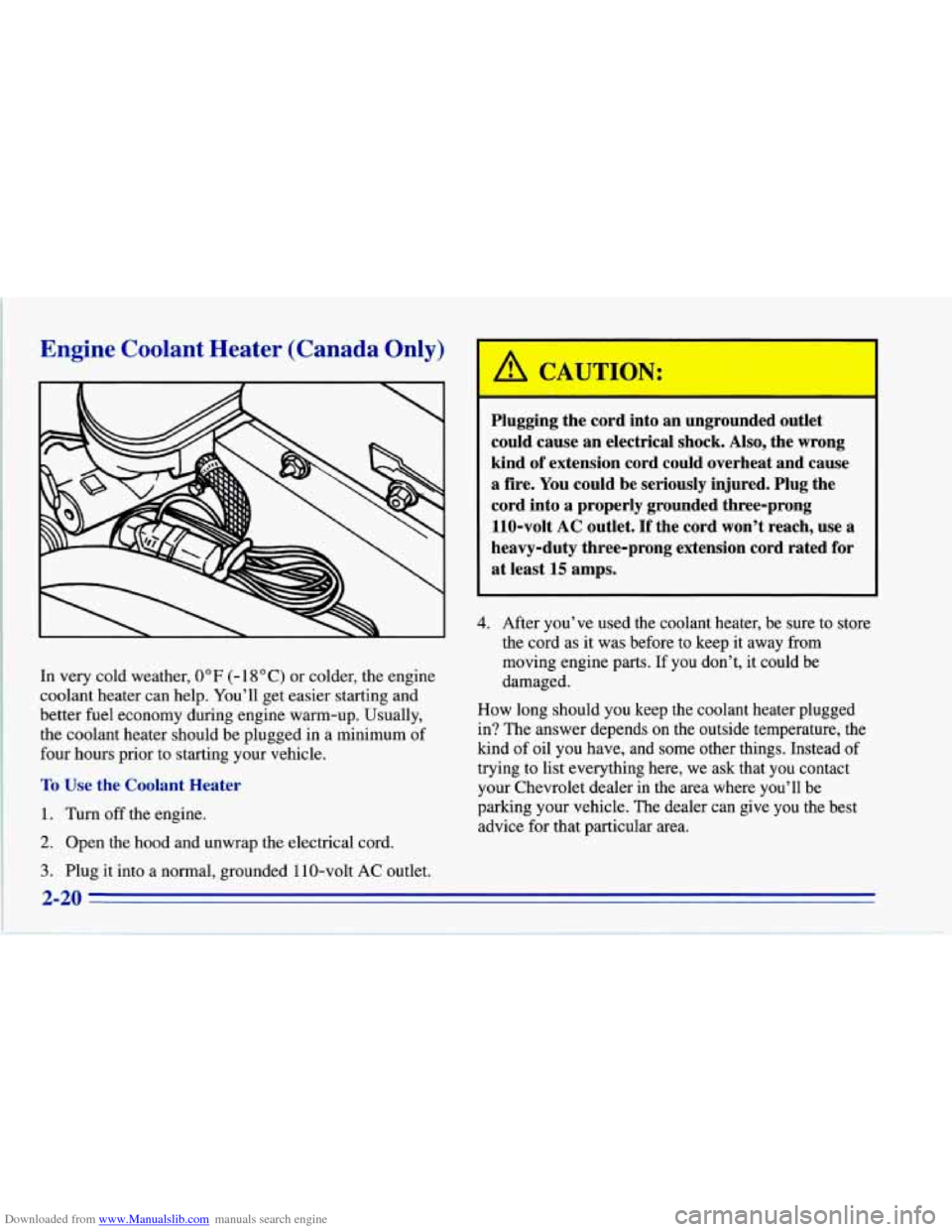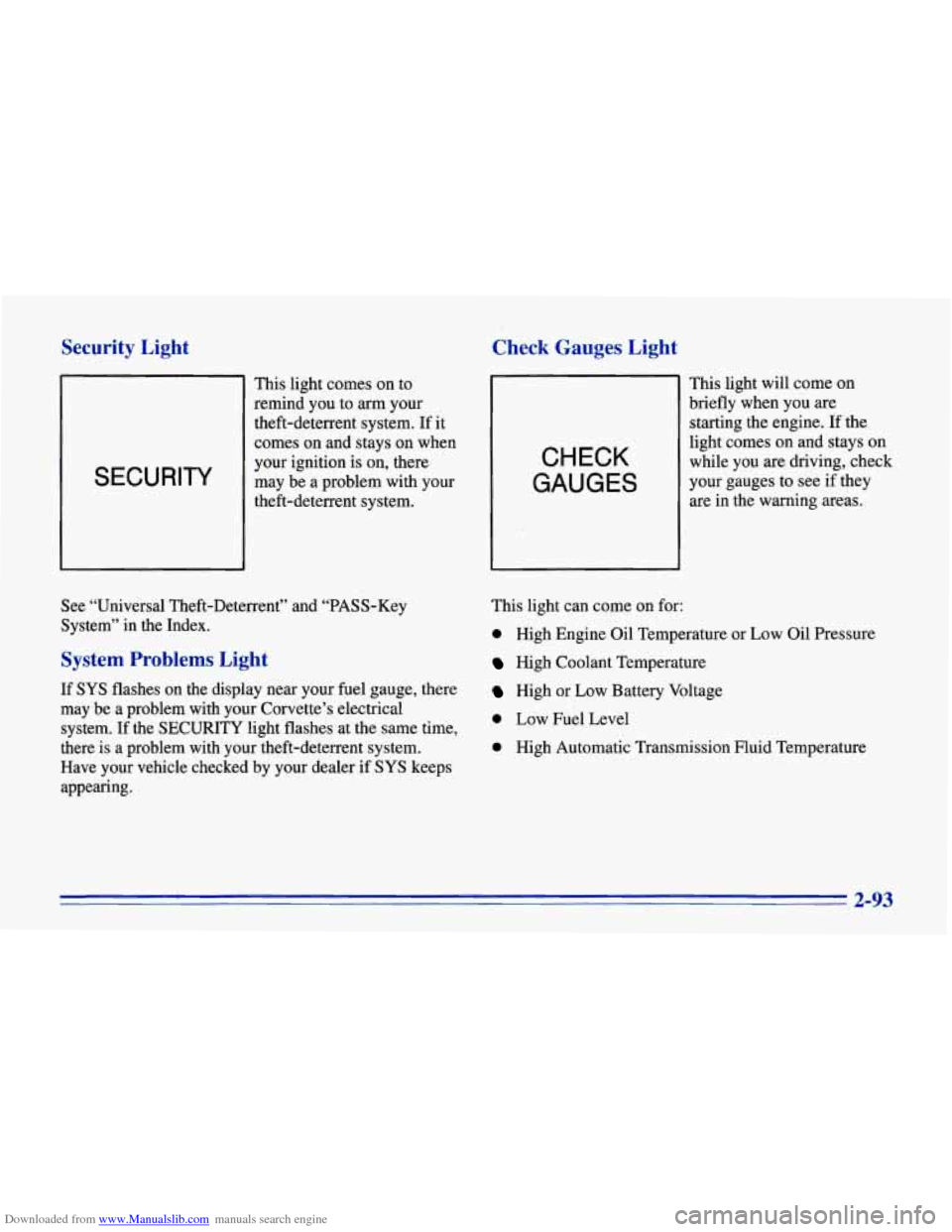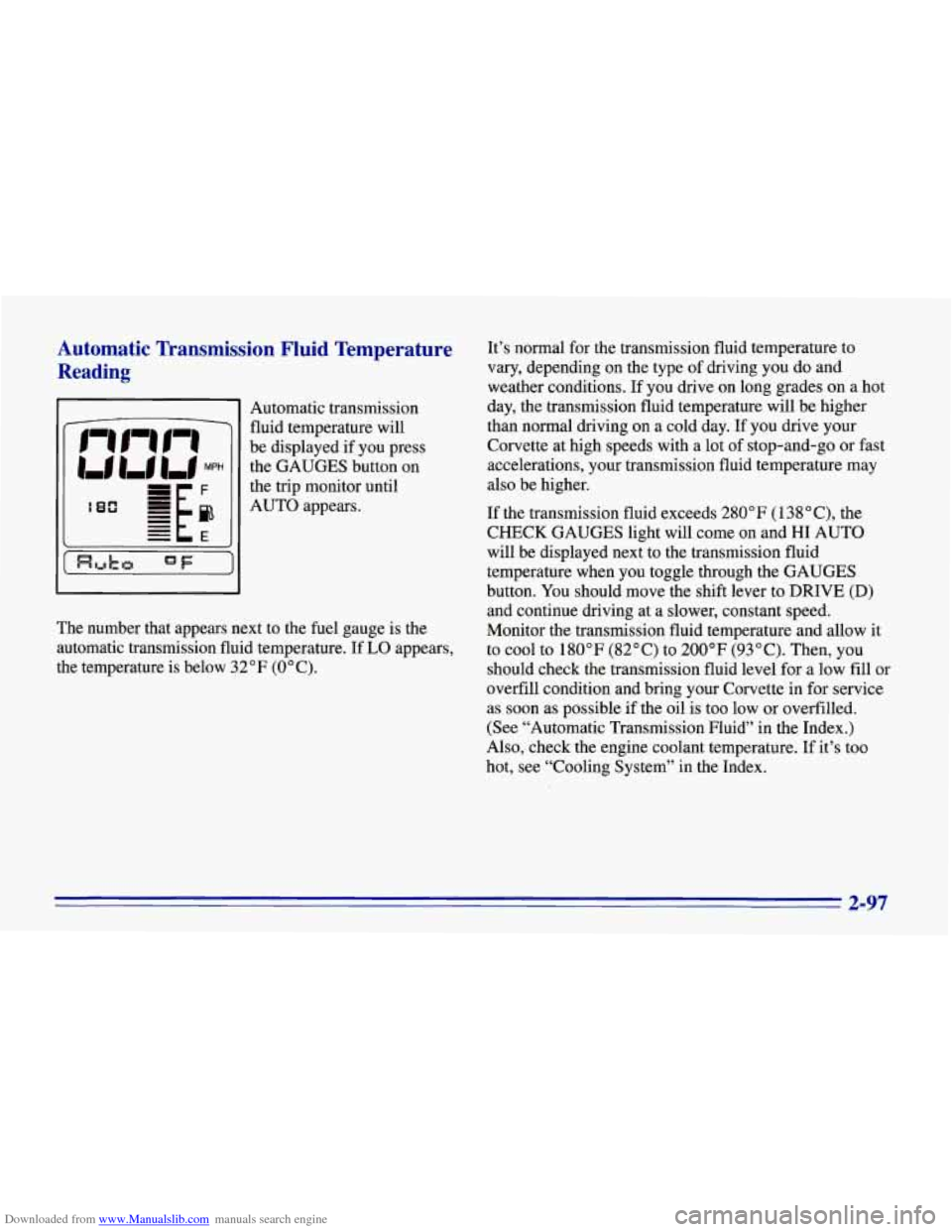Page 63 of 386

Downloaded from www.Manualslib.com manuals search engine Engine Coolant Heater (Canada Only)
In very cold weather, 0°F (- 18 O C) or colder, the engine
coolant heater can help. You’ll get easier starting and
better fuel economy during engine warm-up. Usually,
the coolant heater should be plugged in a minimum of
four hours prior to starting your vehicle.
To Use the Coolant Heater
1. Turn off the engine.
2. Open the hood and unwrap the electrical cord.
3. Plug it into a normal, grounded 110-volt AC outlet.
A CAUTION:
Plugging the cord into an ungrounded outlet
could cause an electrical shock. Also, the wrong
kind of extension cord could overheat and cause
a fire. You could be seriously injured. Plug the
cord into
a properly grounded three-prong
110-volt
AC outlet. If the cord won’t reach, use a
heavy-duty three-prong extension cord rated for
at least
15 amps.
4. After you’ve used the coolant heater, be sure to store
the cord as it was before to keep
it away from
moving engine parts. If you don’t, it could be
damaged.
How long should you keep the coolant heater plugged
in? The answer depends on the outside temperature, the
kind of
oil you have, and some other things. Instead of
trying to list everything here, we ask that you contact
your Chevrolet dealer in the area where you’ll be
parking your vehicle. The dealer can give you the best
advice for that particular area.
Page 132 of 386

Downloaded from www.Manualslib.com manuals search engine Engine Oil Pressure Gauge
0
WA
OIL
PRESS
PSI
The engine oil pressure
gauge shows the engine
oil pressure in psi (pounds
per square inch) or
kPa (kilopascals) when
the engine is running.
Oil pressure should be
20 to 80 psi (140 to 550 Wa).
(In certain situations such as long, extended idles on hot
days, it could read as low as
6 psi (40 kPa) and still be
considered normal.) It may
vary with engine speed,
outside temperature and oil viscosity, but readings above
the shaded area show the normal operating range.
Readings in the shaded area tell you that the engine is
low on oil, or that you might have some other oil
problem. See “Engine Oil”
in the Index.
A CAUTIOh:
Don’t keep driving if the oil pressure is low. If
you do, your engine can become so hot that it
catches fire. You or others could be burned.
Check your oil as soon as possible and have your
vehicle serviced.
I 1
NOTICE:
Damage to your engine from neglected oil
problems can be costly and
is not covered by
your warranty.
2-89
Page 133 of 386
Downloaded from www.Manualslib.com manuals search engine Engine Oil Temperature Gauge
320
OIL TEMP OF
This gauge shows your
engine oil temperature. Oil
temperature may vary with
the type
of driving you do
and weather conditions.
If your gauge pointer moves close to or into the shaded
area and stays there, your oil temperature is too high.
Check the engine coolant temperature and engine oil
level.
If your engine is too hot, see “Engine
Overheating” in the Index. Your vehicle may need
service; see your dealer.
I,
For numeric gauge
measurements, press the GAUGES button on the trip
monitor until
OIL appears.
The number that appears next to the fuel gauge is the oil
temperature.
If LO appears, the temperature is below
32°F (OOC).
2-90
Page 134 of 386

Downloaded from www.Manualslib.com manuals search engine Engine Oil Life Monitor
CHANGE
OIL
The CHANGE OIL light
comes on for a few seconds
when you turn the ignition
on. It will come on and stay
on when it’s time to change
your oil.
The monitor uses oil temperature and engine revolutions
to decide when the oil
is nearly worn out. The light is
only a reminder, though. Be sure
to reset the monitor when your oil
is changed,
even
if the CHANGE OIL light didn’t come on. If you
don’t reset the monitor, it won’t work correctly. Follow
these steps:
1. Turn the key to RUN, but don’t start the engine.
2. Press ENG MET on the trip monitor. Then, within
five seconds, press it again.
3. Within five seconds, press and hold GAUGES on the
trip monitor. The CHANGE OIL light should flash.
4. Hold the GAUGES button until the CHANGE OIL
light stops flashing and goes out. This should take
about
10 seconds.
When the light goes out, the monitor is reset. If
the monitor doesn’t reset, turn the ignition off, then
try again.
2-91
Page 136 of 386

Downloaded from www.Manualslib.com manuals search engine Security Light Check Gauges Light
SECURITY
This light comes on to
remind you to
arm your
theft-deterrent system. If it
comes on and stays on when
your ignition is on, there
may be a problem with your
theft-deterrent system.
CHECK
GAUGES
This light will come on
briefly when you are
starting the engine.
If the
light comes on and stays on
while you are driving, check
your gauges to see if they
are in the warning areas.
See “Universal Theft-Deterrent” and “PASS-Key
System” in the Index.
System Problems Light
If SYS flashes on the display near your fuel gauge, there
may be a problem with your Corvette’s electrical
system. If the
SECURITY light flashes at the same time,
there is
a problem with your theft-deterrent system.
Have your vehicle checked by your dealer
if SYS keeps
appearing. This
light can come on for:
0 High Engine Oil Temperature or Low oil Pressure
High Coolant Temperature
High or Low Battery Voltage
0 Low Fuel Level
0 High Automatic Transmission Fluid Temperature
2-93
Page 139 of 386
Downloaded from www.Manualslib.com manuals search engine Gauge Markings
The analog gauges provide a quick visual reference to
the actual measurements of these gauges. However, you
must keep in mind that the gauges aren't linear. This
means that the middle mark
is not a temperature halfway
between the top and bottom temperatures on the gauge.
1
E
A
p
E
J
For your convenience, the following table gives the
exact reading for each mark.
For numeric gauge measurements, refer to the digital
readings by pressing
GAUGES on the trip monitor.
Marking
Gauge
E
D C B A
Oil 320.F
285°F
250°F 215.F 100.F
Temperature
.(127'C) (113'C) (99'C) (85'C) (38'C) Temperature
260'F
235'F
210'F 185OF 100.F Coolant (160.C)
(145.C)
(121'C) (102OC)
(38-C)
2-96
Page 140 of 386

Downloaded from www.Manualslib.com manuals search engine Automatic Transmission Fluid Temperature Reading
Automatic transmission
fluid temperature will
be displayed if you press
the GAUGES button on
the trip monitor until
AUTO appears.
The number that appears next to the fuel gauge is the
automatic transmission fluid temperature. If
LO appears,
the temperature is below 32°F (0°C). It’s
normal for the transmission fluid temperature to
vary, depending on the type
of driving you do and
weather conditions. If you drive on long grades on a hot
day, the transmission fluid temperature will be higher
than normal driving on a cold day. If you
drive your
Corvette at high speeds with a lot of stop-and-go or fast
accelerations, your transmission fluid temperature may
also be higher.
If the transmission fluid exceeds
280” F (1 38 “C), the
CHECK GAUGES light will come on and HI AUTO
will be displayed next to the transmission fluid
temperature when you toggle through the GAUGES
button. You should move the shift lever to DRIVE
(D)
and continue driving at a slower, constant speed.
Monitor the transmission fluid temperature and allow it
to cool to 180°F (82°C) to 200°F (93°C). Then, you
should check the transmission fluid level for a low fill or
overfill condition and bring your Corvette in for service
as soon as possible if the oil is too low or overfilled.
(See “Automatic Transmission Fluid” in the Index.)
Also, check the engine coolant temperature. If it’s too
hot, see “Cooling System” in the Index.
2-97
Page 243 of 386
Downloaded from www.Manualslib.com manuals search engine What Kind of Oil to Use
Look for two things:
GM4718M
The Corvette engine requires a special oil meeting
GM Standard GM47 18M. Oils meeting this Standard
may be identified as synthetic. However, not all
synthetic oils will meet this GM Standard. You
should look for and use only an oil that meets GM
Standard GM47
1 8M.
NOTICE:
If you use oils that don’t have the GM4718M
Standard designation, you can cause engine
damage not covered by your warranty.
.
RECOMMENDED SAE VlSCOSlTT GRADE ENGIWE OILS ~~~ ~
FOR BEST FUEL ECONOMY AND COW STARTING, SELECT ME LOWEST
SAE VlSCOSlTT GRADE OIL FOR THE EXPECTED TEMPERATURE RANGE.
HOT
WEATHER
I
“F
6100-
+ 80.
+60.
+40.
+20-
0-
7
“C
- +3a
- + 27
- + 16
- +4
--7
- - 18
-1 PREFERRED SAE I, sw-30 111 su
LOOK
FOR THIS
SYMBOL
cow
WEATHER
DO NOT USE SAE 2OW-50 OR ANY OTHER GRADE OIL NOT RECOMMENDED
6-12